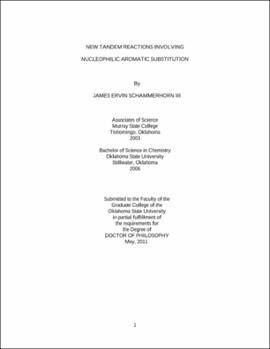| dc.contributor.advisor | Bunce, Richard A. | |
| dc.contributor.author | Schammerhorn, James Ervin, III | |
| dc.date.accessioned | 2013-11-26T08:21:29Z | |
| dc.date.available | 2013-11-26T08:21:29Z | |
| dc.date.issued | 2011-05 | |
| dc.identifier.uri | https://hdl.handle.net/11244/6473 | |
| dc.description.abstract | Scope and Method of Study: The synthesis of 6-nitro-1,2,3,4-tetrahydroquinoline-4-carboxylic esters and 7-nitro-3,4-dihydroquinoxaline-1(2H)-carboxylic esters employing a tandem reductive amination-SNAr reaction is described. In addition, a tandem imine addition-SNAr reaction allowing the preparation of highly substituted 1,2,3,4-tetrahydroquinolines is also reported. | |
| dc.description.abstract | Findings and Conclusions: The development of a new route to nitro-substituted tetrahydroquinoline-4- carboxylic esters and dihydroquinoxaline-1(2H)-carboxylic esters is based on a tandem reductive amination-SNAr reaction. In this sequence, an electron deficient aromatic ring is critical to the final SNAr ring closure. The reaction is also sensitive to steric hindrance in the amine, with primary amines giving the highest yields. Though the current approach to the tetrahydroquinoline systems is not as diastereoselective as our earlier-reported reduction-reductive amination, it does offer a relatively direct route to the title compounds. | |
| dc.description.abstract | The development of a tandem imine addition-SNAr annulation reaction has afforded a new approach to 1,2,3,4-tetrahydroquinolinone-3-carboxylate esters. A series of 1-alkyl-2-aryl-6-nitro-4-oxo-1,2,3,4-tetrahydroquinolinone-3-carboxylate esters have been generated by reacting an imine with a beta-ketoester substituted at C3 by a 2-fluoro-5-nitrophenyl group. Variation in the final product is possible through changes in the structure of the imine and potentially by altering the electron-withdrawing group on the aromatic acceptor. The imines are formed by reacting a 1:1.2 ratio of a primary amine unbranched alpha; to the nitrogen with an aldehyde derivative in N,N dimethylformamide for 6 hours. The beta-ketoester is then added to initiate a spontaneous tandem reaction to produce the substituted 1,2,3,4-tetrahydroquinolinone-3-carboxylate esters in 73-89% yields. The reaction occurs without the need for added base or heat. Future work will include determining conditions that can support the use of other imines to broaden the scope of the process. | |
| dc.format | application/pdf | |
| dc.language | en_US | |
| dc.rights | Copyright is held by the author who has granted the Oklahoma State University Library the non-exclusive right to share this material in its institutional repository. Contact Digital Library Services at lib-dls@okstate.edu or 405-744-9161 for the permission policy on the use, reproduction or distribution of this material. | |
| dc.title | New tandem reactions involving nucleophilic aromatic substitution | |
| dc.contributor.committeeMember | Berlin, Kenneth Darrell | |
| dc.contributor.committeeMember | El Rassi, Ziad | |
| dc.contributor.committeeMember | Materer, Nicholas | |
| dc.contributor.committeeMember | Mort, Andrew J. | |
| osu.filename | Schammerhorn_okstate_0664D_11370 | |
| osu.accesstype | Open Access | |
| dc.type.genre | Dissertation | |
| dc.type.material | Text | |
| dc.subject.keywords | dihydroquinoxaline | |
| dc.subject.keywords | heterocycle | |
| dc.subject.keywords | imine | |
| dc.subject.keywords | tandem | |
| dc.subject.keywords | tetrahydroquinoline | |
| thesis.degree.discipline | Chemistry | |
| thesis.degree.grantor | Oklahoma State University | |
